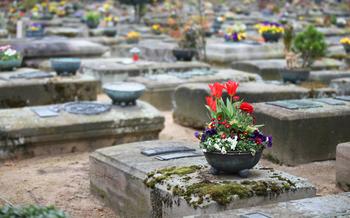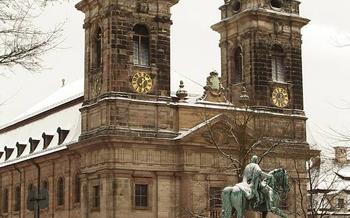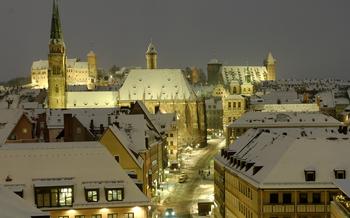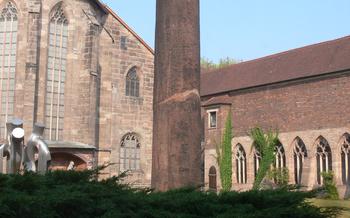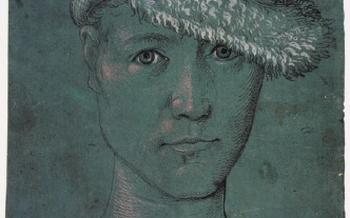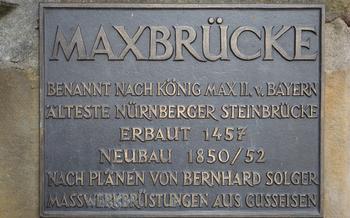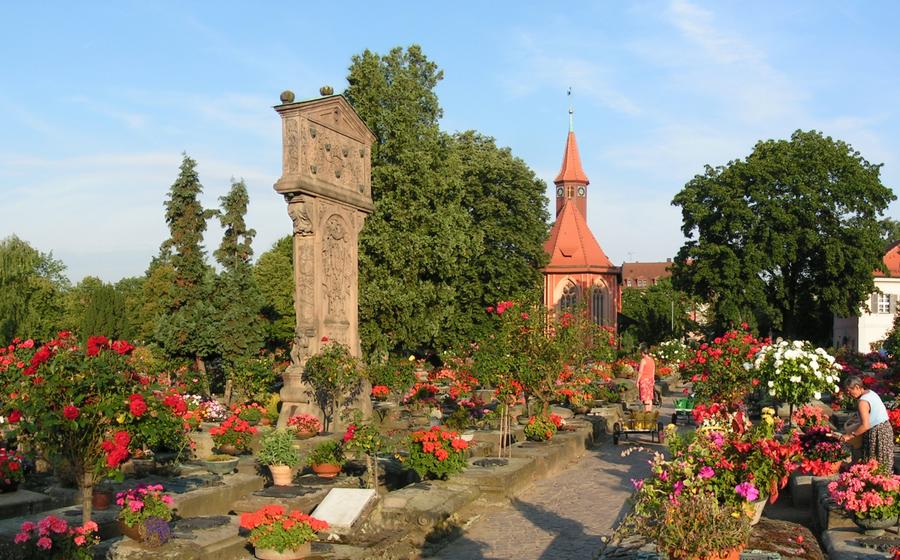
Johannisfriedhof Cemetery
- Historical Significance
- Architectural Highlights
- Famous Graves
- Unique Symbolism
- Commemorating the Past
- Peaceful Haven
- Stories from Beyond
- Guided Tours
- Practical Information
- Photography and Videography
- Respectful Behavior:
- Preservation and Conservation
- Cultural Events
- Insider Tip: The Forgotten Corner of History
Historical Significance
Johannisfriedhof Cemetery stands as a testament to Nuremberg's rich and multifaceted history. Established in 1525, it has witnessed centuries of social, cultural, and political change, becoming an integral part of the city's identity. Over the years, numerous notable figures have found their final resting place within its hallowed grounds, including renowned artists, intellectuals, and leaders who have shaped Nuremberg's legacy. Among them are Albrecht Dürer, the celebrated Renaissance painter and printmaker, whose intricate works continue to captivate art enthusiasts worldwide. The cemetery also houses the graves of prominent industrialists and philanthropists, whose contributions to the city's economic and cultural development are still felt today. Through these individuals and their stories, Johannisfriedhof Cemetery offers a glimpse into the diverse tapestry of Nuremberg's past, providing a tangible connection to the people and events that have shaped this vibrant city.
Architectural Highlights
Johannisfriedhof Cemetery boasts a captivating array of architectural marvels, each contributing to its unique character and historical significance. The Neo-Gothic chapel, a striking centerpiece of the cemetery, stands as a testament to the architectural prowess of the 19th century. Its intricate design, featuring pointed arches, ribbed vaults, and delicate tracery, evokes a sense of awe and reverence.
Other notable structures within the cemetery include the ornate mausoleums and tombs. These grand edifices, adorned with sculptures, carvings, and inscriptions, reflect the wealth and status of the individuals buried within. The symbolism embedded in these architectural elements adds depth and meaning to the cemetery's visual landscape.
One of the most striking tombs is that of the Fürer family. This elaborate monument features a life-size bronze statue of a woman kneeling in prayer, surrounded by intricate carvings and bas-reliefs depicting scenes from the Bible. The tomb of the Cramer-Klett family, with its neoclassical design and allegorical figures, is another notable example of the cemetery's architectural prowess.
These architectural highlights are not merely decorative elements but integral components of the cemetery's story. They reflect the cultural, social, and religious influences that have shaped Nuremberg over the centuries, creating a rich tapestry of history and art that continues to captivate visitors to this day.
Famous Graves
The Johannisfriedhof Cemetery is the final resting place of numerous notable individuals who have left an indelible mark on various fields and disciplines. Among the most prominent figures buried here is Albrecht Dürer, the renowned German Renaissance painter, printmaker, and theorist. His grave is adorned with an intricate sandstone epitaph that pays tribute to his artistic genius.
Another notable figure is Johann Pachelbel, the Baroque composer best known for his iconic Canon in D major. His grave, marked by a simple stone cross, stands as a testament to his enduring musical legacy.
The cemetery is also home to the graves of several prominent political figures, including Willibald Pirckheimer, a humanist scholar and Nuremberg councilman who played a significant role in the city's cultural and political development during the Renaissance.
Furthermore, the cemetery contains the graves of numerous scientists, inventors, and industrialists who contributed to Nuremberg's rich history of innovation and technological advancements. Among them is Peter Henlein, who is widely credited with inventing the first pocket watch, and Johann Philipp Reis, a pioneer in the field of telegraphy.
The graves of these notable figures serve as a poignant reminder of the diverse and influential individuals who have shaped Nuremberg's history and culture. Visitors to the cemetery can pay their respects to these luminaries and learn about their remarkable contributions to society.
Unique Symbolism
The Johannisfriedhof Cemetery is a treasure trove of symbolism, reflecting the cultural and religious beliefs of the time. From the intricate carvings on the tombstones to the arrangement of the graves, each element carries a deeper meaning.
One of the most striking symbols found in the cemetery is the skull and crossbones, a reminder of mortality and the transience of life. This symbol, often associated with death and decay, serves as a memento mori, encouraging visitors to contemplate their own mortality and the importance of living a meaningful life.
Another prevalent symbol is the angel, representing the connection between heaven and earth. Angels are often depicted as guardians, guiding souls to the afterlife or offering comfort to the bereaved. Their presence in the cemetery provides a sense of hope and solace, reminding visitors that even in death, there is a promise of eternal life.
Flowers, too, play a significant symbolic role in the cemetery. Roses, for example, symbolize love, devotion, and remembrance, while lilies represent purity and innocence. These floral tributes are often placed on graves as a way to express love and respect for the deceased.
The weeping willow tree is another powerful symbol found in the cemetery. Its drooping branches symbolize mourning and sorrow, providing a visual representation of the grief felt by those who have lost loved ones.
By understanding the symbolism found in Johannisfriedhof Cemetery, visitors can gain a deeper appreciation for the cultural and religious context of this historic site. These symbols add layers of meaning to the cemetery, transforming it into a place of contemplation, reflection, and connection with the past.
Commemorating the Past
Johannisfriedhof Cemetery serves as a poignant reminder of Nuremberg's tumultuous history. Within its hallowed grounds lie war memorials and monuments that pay tribute to those who lost their lives in conflicts past. The most prominent among these is the War Memorial, erected in 1925 to honor the soldiers who fell during World War I. Its towering obelisk, adorned with intricate carvings, stands as a solemn symbol of sacrifice and remembrance.
Other memorials within the cemetery commemorate victims of World War II, the Franco-Prussian War, and the Napoleonic Wars. Each memorial bears witness to the devastating impact of war on the city and its people. Visitors can also find graves of soldiers from various nations, including France, Russia, and the United States, who lost their lives while fighting in Nuremberg.
During Remembrance Day and other commemorative occasions, the cemetery becomes a site of solemn ceremonies and gatherings. Wreaths are laid, prayers are recited, and speeches are given to honor the fallen and to remind future generations of the horrors of war. These ceremonies serve to reinforce the cemetery's role as a place of remembrance and reflection, ensuring that the sacrifices of those who came before are never forgotten.
Peaceful Haven
Johannisfriedhof Cemetery offers a sanctuary of tranquility and reflection amidst the bustling city of Nuremberg. The serene atmosphere, enhanced by the natural beauty of the surrounding landscape, invites visitors to pause and contemplate the cycle of life. The meticulously maintained grounds, adorned with an array of trees, flowers, and intricate headstones, create a picturesque and peaceful setting.
Strolling through the cemetery, one can't help but feel a sense of serenity wash over them. The gentle whisper of the wind rustling through the leaves, the melodic songs of birds, and the soft crunch of gravel underfoot create a symphony of tranquility. Visitors can find solace and introspection as they wander among the rows of graves, reflecting on the lives of those who have passed and the enduring legacy they left behind.
Whether seeking a moment of quiet contemplation, a place to pay respects to loved ones, or simply an escape from the hustle and bustle of city life, Johannisfriedhof Cemetery offers a haven of peace and tranquility. Its serene atmosphere and natural beauty provide a sanctuary for visitors to connect with their emotions, reflect on the past, and find solace in the present.
Stories from Beyond
Johannisfriedhof Cemetery is steeped in mystery and intrigue, with local legends and ghost stories adding to its allure. One chilling tale speaks of a spectral figure known as the "White Lady of Johannisfriedhof." Legend has it that she is the restless spirit of a young woman who was tragically murdered within the cemetery walls. Visitors claim to have seen her apparition wandering among the tombstones, her white dress flowing eerily in the moonlight. Another haunting tale tells of a ghostly procession of soldiers that marches through the cemetery on certain nights, their footsteps echoing through the silent grounds. These stories, deeply rooted in local folklore, add an element of mystery and fascination to the already captivating atmosphere of Johannisfriedhof Cemetery.
Guided Tours
Johannisfriedhof Cemetery offers guided tours for visitors seeking a deeper understanding of its history, symbolism, and notable figures. These tours are led by knowledgeable guides who provide fascinating insights into the lives and legacies of the individuals buried here.
Various themes and topics are covered during these tours, including the cemetery's architectural highlights, the stories behind the famous graves, and the cultural and historical significance of the site. Guides often share anecdotes and lesser-known facts, bringing the past to life and creating a truly immersive experience.
For those wishing to make the most of their guided tour, here are some insider tips:
-
Book in Advance: Tours tend to fill up quickly, especially during peak tourist season. To avoid disappointment, it's advisable to book your spot in advance, either online or through the cemetery's office.
-
Choose a Specialized Tour: If you have specific interests, such as architecture, history, or art, inquire about specialized tours that focus on these aspects of the cemetery.
-
Ask Questions: Don't hesitate to ask your guide questions throughout the tour. They are there to share their knowledge and provide insights, so take advantage of their expertise.
-
Respect the Environment: Remember that Johannisfriedhof is a place of remembrance and tranquility. Be respectful of the surroundings, keep noise levels low, and avoid disturbing other visitors.
Practical Information
Reaching Johannisfriedhof Cemetery is a breeze with various transportation options available. The cemetery is conveniently located within walking distance from the city center, making it easily accessible on foot or by bicycle. For those who prefer public transport, tram lines 4 and 6 stop right outside the cemetery's main entrance, providing a quick and hassle-free commute. There are also ample parking spaces available for visitors arriving by car.
To ensure a comprehensive and enjoyable experience, consider allocating at least an hour for your visit. The cemetery's serene atmosphere invites visitors to take their time, wander through its pathways, and appreciate the historical significance and beauty of the grounds. Plan your visit during the late afternoon or early evening to capture the warm, golden light that bathes the cemetery in a magical glow.
Photography and Videography
The Johannisfriedhof Cemetery is a treasure trove for photographers and videographers seeking to capture the beauty and historical significance of this sacred space. While respecting the privacy of the deceased and the solemnity of the environment, visitors are welcome to document their experiences through photography and videography. Here are some guidelines and tips to ensure respectful and impactful documentation:
- Respectful Conduct:
- Always seek permission from the cemetery staff or family members before photographing or filming specific graves or memorials.
- Be mindful of your surroundings and avoid disturbing mourners or visitors seeking solace.
-
Refrain from using flash photography, as it can be disruptive and disrespectful.
-
Composition and Lighting:
- Utilize the natural light to your advantage. The soft, diffused light of dawn or dusk can create stunning compositions.
- Experiment with different angles and perspectives to capture unique and compelling shots.
-
Incorporate the surrounding landscape, such as trees, flowers, or architectural elements, to add depth and context to your images.
-
Symbolism and Details:
- Pay attention to the symbolism and iconography found on tombstones, memorials, and sculptures. These elements can provide insights into the lives and beliefs of the individuals buried here.
-
Capture close-ups of intricate carvings, inscriptions, or decorative motifs to reveal the craftsmanship and artistry of the cemetery's monuments.
-
Storytelling Through Video:
- If creating a video, consider incorporating interviews with historians, cemetery staff, or family members to provide historical context and personal stories.
-
Use slow, steady camera movements to convey the serene atmosphere and allow viewers to connect with the individual stories represented by the graves.
-
Ethical Considerations:
- Always prioritize respect and sensitivity when capturing images or videos. Avoid sensationalizing or exploiting the cemetery's history or the lives of the deceased.
- Be mindful of privacy concerns and avoid filming or photographing individuals without their consent.
Respectful Behavior:
When visiting the Johannisfriedhof Cemetery, it is essential to maintain respectful conduct. Remember that this is a place of remembrance and mourning for many families and friends. As visitors, we should prioritize respectful behavior to honor those laid to rest here.
Refrain from loud conversations, laughter, or any behavior that may disturb the peaceful atmosphere of the cemetery. Be mindful of your surroundings, and avoid touching or leaning on tombstones or memorials. These are not just decorative pieces but hold significant emotional value for the deceased's loved ones.
It is important to be considerate of other visitors who may be seeking solace or paying their respects. Allow them to grieve and reflect in peace. If you notice someone visibly upset or emotional, offer your condolences or simply acknowledge their presence with a nod.
Remember, the Johannisfriedhof Cemetery is not just a tourist attraction but a sacred space that holds deep meaning for the community. By being respectful and mindful of your actions, you can contribute to preserving the tranquility and dignity of this historic cemetery.
Preservation and Conservation
Johannisfriedhof Cemetery, steeped in history and cultural significance, faces the ongoing challenge of preserving its historical integrity while accommodating the needs of modern times. The cemetery's administration, in collaboration with heritage organizations, works diligently to maintain the site's original character and protect its unique features. This delicate balancing act involves careful restoration projects, regular maintenance, and ongoing documentation of the cemetery's assets.
One of the key challenges lies in addressing the natural aging process of the cemetery's structures and monuments. Weather, environmental factors, and the passage of time can take their toll on the intricate carvings, sculptures, and headstones. Skilled artisans and conservators employ specialized techniques to restore these elements to their former glory, ensuring their preservation for future generations.
Balancing the need for accessibility with the preservation of the cemetery's tranquility is another delicate task. While providing access to visitors, particularly those with disabilities, is essential, it must be done in a way that respects the sacred nature of the site. Careful planning and thoughtful design solutions, such as accessible pathways and ramps, can help achieve this delicate balance.
The preservation of Johannisfriedhof Cemetery also relies on the cooperation and support of visitors. By adhering to respectful behavior, avoiding touching or leaning on monuments, and refraining from disturbing the natural surroundings, visitors can contribute to the ongoing preservation efforts.
Cultural Events
Johannisfriedhof Cemetery serves as a unique venue for various cultural events, concerts, and exhibitions throughout the year. These events offer an opportunity to experience the cemetery's rich history and cultural significance from a different perspective.
One of the most popular events held at the cemetery is the annual "Nuremberg Cemetery Nights." During this special evening event, visitors can explore the cemetery after dark, guided by lanterns and the stories of its past residents. Performers bring the cemetery's history to life through theatrical performances, music, and storytelling.
The cemetery also hosts concerts and musical performances featuring local and international artists. The serene atmosphere and unique acoustics of the cemetery create an intimate and unforgettable setting for these events.
Exhibitions and art installations are also occasionally held within the cemetery grounds, showcasing the work of local artists and exploring themes related to death, remembrance, and the afterlife.
These cultural events not only provide a platform for artistic expression but also contribute to the ongoing preservation and appreciation of Johannisfriedhof Cemetery as a cultural heritage site.
Insider Tip: The Forgotten Corner of History
Venture beyond the main paths of Johannisfriedhof to discover a hidden corner where time seems to stand still. Among the weathered tombstones, you'll find the final resting place of forgotten souls, their stories lost to the passage of time. Their graves, adorned with faded inscriptions and overgrown with ivy, offer a glimpse into the lives of ordinary people who once called Nuremberg home. Take a moment to pay your respects to these forgotten souls and reflect on the transience of life.
